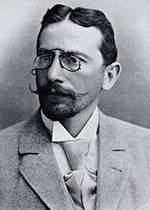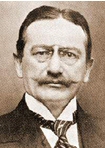Tarrasch Siegbert (05.03.1862 – 17.02.1934)
 German player, one of the world’s best players at the beginning of the twentieth century. He played chess while studying medicine in Berlin and Halle. At the Congress of the German Chess Federation in Nuremberg in 1883, he received the title of Master, but he began to show great success in playing only in 1883. He won several master tournaments organised by the German Chess Federation and an international tournament in Manchester in 1890. Due to his tournament achievements, he was offered two challenges: the first one from the World Champion Steinitz to play at Havana and the second, from the young chess player Lasker. He refused both, refusing to play with Steinitz, because he had no time to travel to Havana and declining to play with Lasker on the condition that the latter should win at least one international tournament. Both refusals were rather characteristic, since he did not consider himself to be a professional chess player and spent a lot of time in his medical practice. His principles were conservative: order, social norms, pride and reputation above all. He was very proud of his successes in chess, they being of great meaning to him in the sphere of self-admiration in some way. It was quite evident to Tarrasch that he should try to win the World Championship, especially after his victory at Hastings in 1895.
German player, one of the world’s best players at the beginning of the twentieth century. He played chess while studying medicine in Berlin and Halle. At the Congress of the German Chess Federation in Nuremberg in 1883, he received the title of Master, but he began to show great success in playing only in 1883. He won several master tournaments organised by the German Chess Federation and an international tournament in Manchester in 1890. Due to his tournament achievements, he was offered two challenges: the first one from the World Champion Steinitz to play at Havana and the second, from the young chess player Lasker. He refused both, refusing to play with Steinitz, because he had no time to travel to Havana and declining to play with Lasker on the condition that the latter should win at least one international tournament. Both refusals were rather characteristic, since he did not consider himself to be a professional chess player and spent a lot of time in his medical practice. His principles were conservative: order, social norms, pride and reputation above all. He was very proud of his successes in chess, they being of great meaning to him in the sphere of self-admiration in some way. It was quite evident to Tarrasch that he should try to win the World Championship, especially after his victory at Hastings in 1895.
That year appeared his famous workDreihundert Schachparteien, where he revealed his views on chess theory and methods of play in combination with his autobiographical details. Thus, this work can serve as a source of the history of chess of that time. His comments on the play of the previous Grandmasters are sophisticated and his teaching sentences, dogmatic. After his refusal to play the title-match with Lasker in St. Petersburg in 1895-96, he played with him at Nuremberg in 1896 and lost. Having won a Jubilee Tournament in Vienna in 1898, he made a kind of indirect challenge to Lasker for the World Championship. At that time, he was playing chess at his best. Due to his cautious tactics and straightforward strategy, he beat his opponent. After another victory in Monte Carlo in 1903, he officially challenged Lasker again. The terms were agreed upon, but the tournament was played only in 1908, 12 years later. The match was played with conditions which were rather mild for Lasker. He exploited the occasion that he could play only in Nuremberg. There were 16 games played with the outcome +8-3=5 for Lasker, which meant that Lasker was the winner. Tarrasch found some explanations and excuses for his defeat, but in general, he hardly believed them. He was very upset by the loss, and it affected his career in chess. He played his last big tournament before World War I in St. Petersburg in 1914, where he was fourth after Lasker, Capablanca and Alekhine. It was possible to play a return match because of isolation during the war in 1916, but it was a crushing defeat for Tarrasch with the score 5-0. After the war, he participated in some tournament, being invited to play always and everywhere and given respect. He played in Goteborg, Carlsbad, Piestany, Baden-Baden and Semmering, where he was 7./8. together with Reti at the age of 64, a half-point after Rubinstein. Retired from tournament play, he devoted himself to literature. His last and, probably the best, work Das Schachspiel, an instructional book, was written in 1913. He died on 17 February 1934 at the age of 72.



